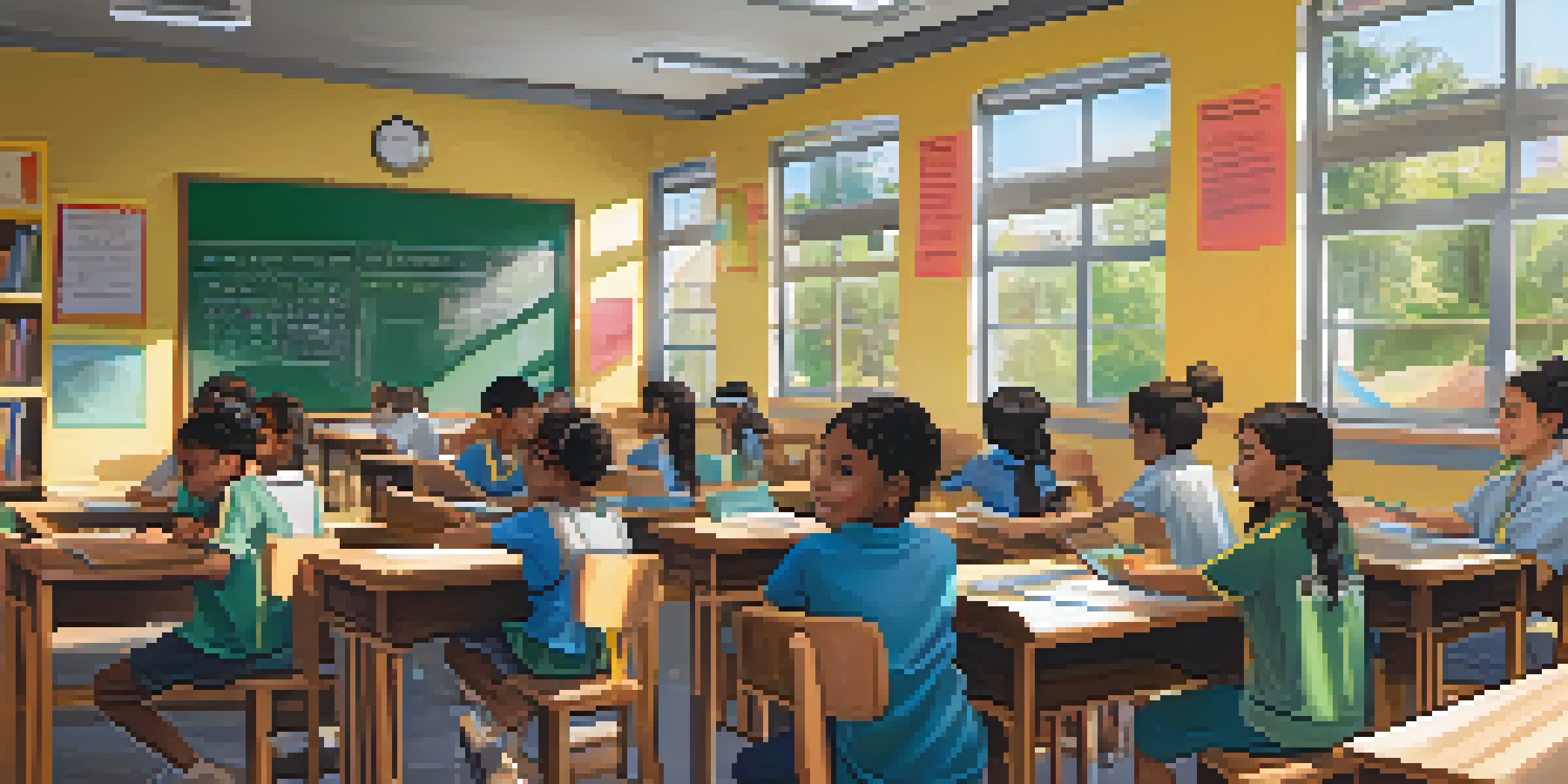The Impact of COVID-19 on Jersey City's School Systems

Initial Disruptions: School Closures and Remote Learning
When COVID-19 hit in March 2020, Jersey City schools faced immediate closures to ensure the safety of students and staff. This abrupt shift left many teachers scrambling to adapt their lesson plans for remote learning, a format that many were not trained for. Students, too, found themselves navigating a new normal, often struggling to adjust to online classes without the usual support they received in-person.
Education is not preparation for life; education is life itself.
The digital divide became glaringly apparent, as not all students had access to the necessary technology or reliable internet. Families with limited resources faced significant challenges, which exacerbated existing inequalities in the education system. As schools transitioned to remote learning, educators worked tirelessly to find creative solutions to engage students and provide them with the resources they needed.
Despite the hurdles, this period also sparked innovation among educators. Many teachers developed new skills in digital tools and platforms, discovering ways to keep students engaged through interactive lessons and virtual activities. The experience laid the groundwork for a more flexible approach to education that may continue in the future.
Mental Health Challenges for Students and Educators
The pandemic's impact extended beyond academics; it significantly affected the mental health of students and educators alike. The isolation from peers and the stresses of a pandemic created an environment where anxiety and depression flourished. Many students reported feeling disconnected and overwhelmed, which made the learning process even more difficult.

Educators, too, faced their own mental health struggles while trying to support their students. The pressure to adapt quickly and effectively, coupled with their own concerns for personal and family safety, created a challenging atmosphere. Schools began to recognize this issue and started implementing mental health resources, such as counseling services and wellness programs.
Adapting Education for New Realities
Schools are shifting curricula to incorporate social-emotional learning and hybrid models, addressing students' diverse needs post-pandemic.
These efforts highlight an important shift in how schools view mental health. The pandemic underscored the necessity of supporting not just academic success, but also emotional well-being. This realization may lead to lasting changes in how mental health is prioritized in Jersey City's educational framework.
Adapting Curricula to Meet New Learning Needs
As schools reopened, it became clear that curricula needed to adapt to the new realities of learning. Educators began to incorporate more social-emotional learning (SEL) into their lessons, recognizing that students needed additional support as they re-acclimated to in-person education. This shift aimed to help students process their experiences and build resilience moving forward.
The only thing worse than being blind is having sight but no vision.
Additionally, schools explored hybrid models that combined in-person and online learning, providing flexibility for families still concerned about health risks. This innovative approach allowed educators to reach students in various ways, catering to different learning styles and needs. It also encouraged students to become more self-directed learners, a skill that will serve them well in the future.
The pandemic has thus prompted a reevaluation of traditional teaching methods. It's an opportunity for schools to rethink how they deliver education, ensuring it is more inclusive and responsive to the diverse needs of students. This evolution in curricula may pave the way for a more engaging and effective educational experience.
Technology's Role in Modernizing Education
COVID-19 accelerated the integration of technology in Jersey City's school systems. With remote learning being the only viable option for a period, schools invested in digital tools that transformed classrooms into tech-savvy environments. From learning management systems to interactive software, technology has become an essential part of education.
Teachers began to leverage online resources, enabling them to create more dynamic and engaging lessons. Virtual field trips, online discussions, and interactive presentations became common, allowing students to explore subjects in ways that traditional methods couldn't provide. This tech infusion not only enhanced learning but also prepared students for a future where digital literacy is paramount.
Community Engagement in Education
The pandemic underscored the importance of community support, leading to increased parental involvement and local collaboration to enhance student learning.
However, this reliance on technology also raised concerns about screen time and its effects on students. Educators and parents alike have had to navigate the balance between leveraging tech for learning and ensuring students maintain healthy habits. As schools continue to evolve, finding this balance will be key to sustaining the benefits of technology in education.
Community Support and Engagement in Education
The pandemic highlighted the importance of community support in Jersey City's education system. Local organizations, businesses, and community members stepped up to provide resources, from food drives to tech donations. This collaboration demonstrated how a united community can enhance student learning experiences, especially during challenging times.
Parents also became more involved in their children's education, often taking on roles as co-educators while schools were closed. This shift fostered greater communication between families and schools, with many educators appreciating the insights parents could offer about their children’s learning styles and needs. Such partnerships are invaluable in creating a supportive educational environment.
Moving forward, this community engagement can lead to more robust support systems for students. Schools can work alongside local organizations to create programs that address both academic and social needs, reinforcing the idea that education is a shared responsibility. Building on this momentum could lead to innovative initiatives that benefit the entire community.
Equity and Access: Addressing Long-standing Issues
The pandemic exacerbated existing inequalities in Jersey City's school systems, bringing equity issues to the forefront. Many students lacked access to necessary resources, such as reliable internet and technology, which hindered their ability to participate fully in remote learning. This digital divide highlighted the need for systemic changes to ensure all students receive a quality education.
In response, schools began implementing measures to bridge these gaps, such as distributing devices and improving internet access in underserved areas. These initiatives are crucial in leveling the playing field, allowing every student the opportunity to succeed, regardless of their background. This focus on equity is not just a reaction to the pandemic but a long-term commitment to building a fairer education system.
Focus on Equity and Access
COVID-19 highlighted existing inequalities in education, prompting initiatives to improve access to technology and resources for all students.
As Jersey City moves forward, addressing these disparities will remain a priority. The lessons learned during the pandemic can inform future policies and practices aimed at fostering an inclusive educational environment. By prioritizing equity and access, schools can create a more just system for all students.
Looking Ahead: The Future of Education in Jersey City
As we reflect on the impact of COVID-19, it's clear that Jersey City's school systems are at a pivotal moment. The challenges faced have prompted innovative solutions and a renewed focus on mental health, technology, and community engagement. These changes may shape the future of education in ways we are just beginning to understand.
The lessons learned during the pandemic could lead to a more adaptable education model that prioritizes student well-being alongside academic success. As schools continue to evolve, they have the opportunity to create an environment that not only prepares students for the future but also supports them holistically.

Ultimately, the future of education in Jersey City is a collective effort. By embracing the changes prompted by the pandemic and continuing to foster collaboration among educators, families, and the community, we can build a stronger, more resilient school system. The journey ahead may be challenging, but it's also filled with promise.